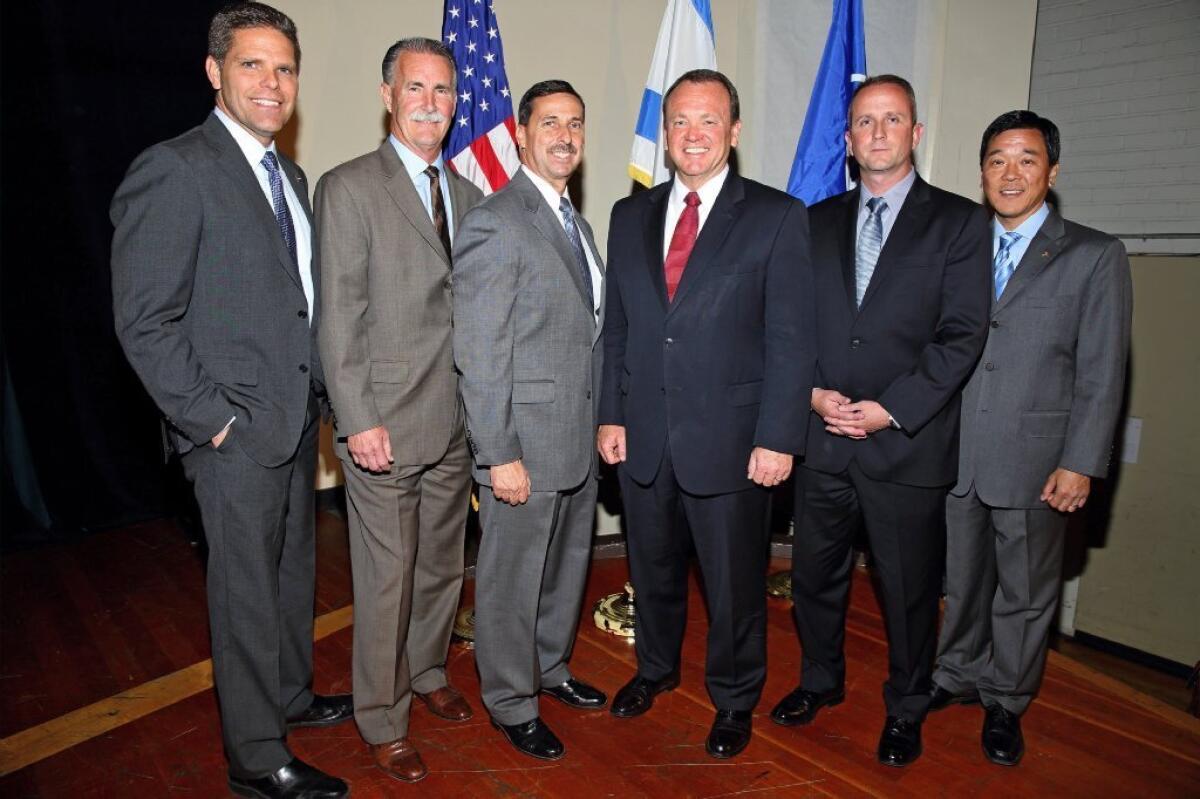Op-Ed: An L.A. County sheriff’s race like no other

- Share via
With seven candidates, no incumbent and no odds-on favorite, the June 3 election for Los Angeles County sheriff is the most wide-open race in years. But how wide open? And in how many years?
The answer to both questions depends in part on how one categorizes Lee Baca’s election in 1998. Baca resigned in January to avoid a tough campaign for a fifth term. But when he first ran in 1998, incumbent Sheriff Sherman Block died a few days before election day. Block’s name was still on the ballot, however. Block’s supporters actually stepped up their campaign, arguing that voters should elect the dead man to pay tribute to him, and to allow the Board of Supervisors to name a sheriff other than Baca.
Still, Baca prevailed. So 16 years ago there was an incumbent, and Baca beat him. Or there was an incumbent’s name on the ballot, but not an actual incumbent.
Let’s press on. When was the last time a challenger defeated a living incumbent L.A. sheriff?
Certainly not in 1982, when Block first became sheriff. Block’s mentor, Sheriff Peter J. Pitchess, had agreed to retire before the end of his term if the Board of Supervisors “would promise to appoint Sherm,” The Times quoted him as saying. The board did, and Block held the top spot for 16 years.
That’s how things were done. Three times in the last century an L.A. County sheriff appointed a loyal undersheriff, then bowed out in his favor, perpetuating a kind of regal line of succession. (Which explains in part why Block was so put out that Baca challenged him in 1998 and why the board had such a sense of entitlement to pick the sheriff.)
Even when voters were in on the act, the elections were tightly scripted. Consider Sheriff Eugene Biscailuz, who in 1958 had arranged for Pitchess to succeed him. But he went through the (rare) formality of actually letting the voters decide in a race with no incumbent. “The decision will be made by all the people of Los Angeles County,” Biscailuz told The Times. “The decision must be theirs, not mine.”
But he added: “When my friends ask me who I should vote for next June, I will say frankly that Undersheriff Peter J. Pitchess will receive my vote.”
The voters got the hint. That 1958 primary election was the last time candidates ran for sheriff with no incumbent on the ballot.
But wait. Was that really a “wide-open” race like this year’s? Not even close. Pitchess was obviously the heir apparent, a virtual incumbent. When was the last time a race was truly wide open?
Not when Biscailuz became sheriff, way back in 1932; he was appointed to the job by the Board of Supervisors at the direction of the preceding sheriff, former Ku Klux Klansman William I. Traeger. The supervisors also had appointed Traeger in 1921 after essentially ousting John C. Cline.
Cline had locked horns with the board continually. Fed up, the board chairman, Jonathan S. Dodge, sued him for misfeasance in office. The charges included fixing traffic tickets and pocketing per diem fees (as was the norm before the county charter was adopted) instead of depositing them into the county treasury. Officially, it was a judge who gave Cline the boot.
Cline got on the wrong side of the supervisors by challenging — and defeating — their guy, Sheriff William Hammel, in 1914.
And that election — a full century ago — was the last time a living incumbent Los Angeles County sheriff was defeated.
But that was still not a wide-open race. We’re still digging to find a time when voters actually chose a new sheriff, with no incumbent or incumbent’s designee on the ballot.
You’d think this would be easy to nail down. But Los Angeles was so different then — before voters adopted the 1913 “home rule” charter, with its civil service protections and other progressive reforms. Candidates were anointed by political bosses and nominated at county party conventions instead of selected in primary elections. Sheriffs’ tenures were brief, deputies were openly hired and fired based on political support, and the sheriff was paid in part by the fees and fines he collected.
In the 1890s and the first decade of the 20th century, four men wrestled over the office — Cline, Hammel, John Burr and William White — along with their respective factions of job seekers and patrons. When Burr was elected in 1894, he went into hiding to avoid a throng of would-be deputies, and in so doing, he failed to show up at the proper time and place to take office. The job was declared vacant, and the Board of Supervisors ended up appointing him.
So when was the last time the choice was this wide open, with no incumbent and no front-runner, and with voters firmly in charge of who the next sheriff would be? In the era in which county politics were something we’d recognize today? There really has never been a sheriff’s election like this one in Los Angeles County. So celebrate, voters. And choose.
More to Read
A cure for the common opinion
Get thought-provoking perspectives with our weekly newsletter.
You may occasionally receive promotional content from the Los Angeles Times.











